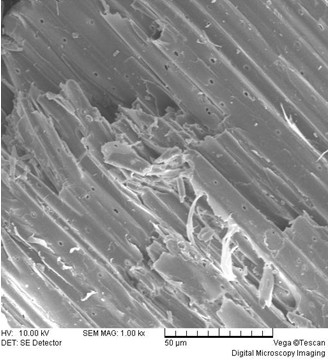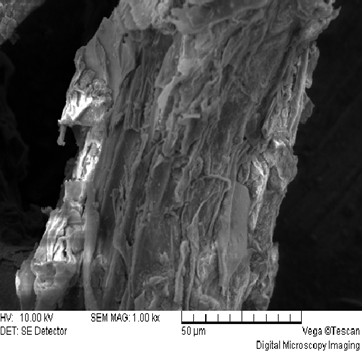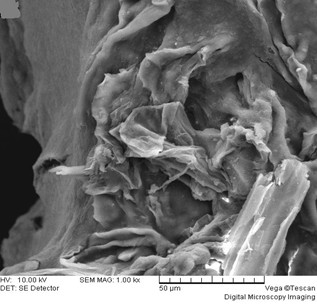Method for extracting cellulose from tobacco
A technology of cellulose and cellulose solution, which is applied in the fields of tobacco, tobacco processing, food science, etc., can solve the problems of complex spatial structure crystallinity and hinder the industrial application of cellulose, and achieve low cost, low pollution, and improved dissolution efficiency Effect
- Summary
- Abstract
- Description
- Claims
- Application Information
AI Technical Summary
Problems solved by technology
Method used
Image
Examples
Embodiment 1
[0023] Take 100g of tobacco with a particle size of 20 meshes, add 1-butyl-3-methylimidazolium chloride salt equivalent to 10 times the mass of tobacco, and carry out a dissolution reaction at 100°C for 4 hours to obtain a reaction solution. Liquid is carried out solid-liquid separation, gets liquid, and described liquid is cellulose solution; Add the deionized water that volume is 3 times in gained cellulose solution, filter after stirring for 30 minutes, gained filter residue is cellulose, and cellulose quality is 9.6g, the cellulose yield is 43.63%.
Embodiment 2
[0025] Accurately weigh 170 g of NaOH and dissolve it in 510 mL of distilled water to prepare a NaOH solution with a mass concentration of 25%. Weigh 120g of tobacco with a particle size of 20 mesh and put it into a three-necked bottle, then add 500mL of NaOH solution with a mass concentration of 25%, and stir it mechanically for 1 hour. After the reaction, wash and filter with distilled water until the filtrate is neutral. The filter residue was vacuum-dried at 70°C for later use. Take 100g of tobacco with a particle size of 20 meshes, add 1-butyl-3-methylimidazolium chloride salt equivalent to 10 times the mass of tobacco, and carry out a dissolution reaction at 100°C for 4 hours to obtain a reaction solution. Liquid is carried out solid-liquid separation, gets liquid, and described liquid is cellulose solution; Add the deionized water that volume is 5 times in gained cellulose solution, filter after stirring for 30 minutes, gained filter residue is cellulose, and cellulose ...
Embodiment 3
[0027] Weigh 120g of tobacco with a particle size of 20 mesh and put it into a three-neck bottle, then add 500mL of hydrochloric acid solution with a mass concentration of 10%, and stir it mechanically for 1.5h. After the reaction, wash and filter with distilled water until the filtrate is neutral. . The filter residue was vacuum-dried at 70°C for later use. Take 100g of tobacco with a particle size of 20 meshes, add 1-butyl-3-methylimidazolium chloride salt equivalent to 10 times the mass of tobacco, and carry out a dissolution reaction at 100°C for 4 hours to obtain a reaction solution. Liquid is carried out solid-liquid separation, gets liquid, and described liquid is cellulose solution; Add the deionized water that volume is 3 times in gained cellulose solution, filter after stirring for 30 minutes, gained filter residue is cellulose, and cellulose quality is 19.5g, which is 45.01% higher than the untreated raw cellulose, and the cellulose yield is 88.64%.
PUM
| Property | Measurement | Unit |
|---|---|---|
| Particle size | aaaaa | aaaaa |
| Particle size | aaaaa | aaaaa |
Abstract
Description
Claims
Application Information
 Login to View More
Login to View More - R&D
- Intellectual Property
- Life Sciences
- Materials
- Tech Scout
- Unparalleled Data Quality
- Higher Quality Content
- 60% Fewer Hallucinations
Browse by: Latest US Patents, China's latest patents, Technical Efficacy Thesaurus, Application Domain, Technology Topic, Popular Technical Reports.
© 2025 PatSnap. All rights reserved.Legal|Privacy policy|Modern Slavery Act Transparency Statement|Sitemap|About US| Contact US: help@patsnap.com



